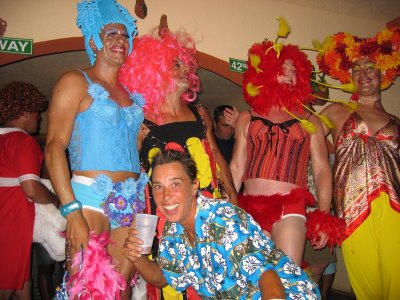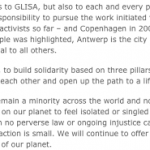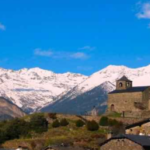GlobalGayz received a vociferous message a while ago from an irate, outspoken and well-written lesbian protesting that Belize was poorly represented on our site. Previous to her message there was little of ‘inside’ value we could find on the Internet about LGBT life in Belize.
 However, that shortcoming has now been repaired thanks to some thoughtful comments from Colette who lives with her partner Maya (and their dogs, chickens and occasional wild animals) in a mid-sized holiday town called San Pedro on the Caribbean Coast of Belize, close to the largest coral reef in the Northern Hemisphere. Needless to say it’s a popular tourist destination in the winter season.
However, that shortcoming has now been repaired thanks to some thoughtful comments from Colette who lives with her partner Maya (and their dogs, chickens and occasional wild animals) in a mid-sized holiday town called San Pedro on the Caribbean Coast of Belize, close to the largest coral reef in the Northern Hemisphere. Needless to say it’s a popular tourist destination in the winter season.
Wikipedia has a nice succinct description of Belize:
“Belize, formerly British Honduras, is a country in Central America. Belize was affiliated with the British Empire prior to gaining its independence in 1981. Belize has a diverse society, composed of many cultures and speaking many languages. It is the only country in Central America where English is the official language. Kriol and Spanish are also widely spoken. With 8,867 square miles (22,960 km2) of territory and 320,000 people (2008 est.), the population density is the lowest in the Central American region and one of the lowest in the world. Belize is the least populous non-island nation outside of Europe. Culturally, Belize considers itself to be both Caribbean and Central American.”
LGBT Life in Belize
Colette can take it from here:
We had spent three years investigating and exploring Belize as a potential new home. High on our list was tolerance, as we are an openly same-sex couple. We traveled extensively on the mainland of Belize and spent time on the beautiful cayes off the coast, nestled like jewels in the Caribbean Sea. We found Belizeans to be very tolerant and friendly. We were welcomed wherever we visited and the only time people were surprised by our relationship they demonstrated curiosity not animosity.
We loved the mainland, with its rich cultural diversity and beautiful rain forests filled with the most amazing creatures. Belize is a good size country, with a tiny population. It is a developing nation and there is a great deal of poverty. Access to education and good health care can be difficult and many are subsistence farmers or fisherfolk.
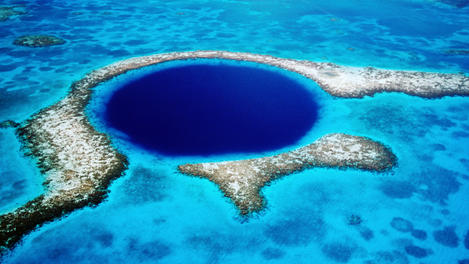 We settled on Ambergris Caye in the town of San Pedro. This caye is a tropical jewel sitting in the turquoise water of the Caribbean sea, overlooking the Meso American Reef, the largest barrier reef in the Northern Hemisphere just off the coast of Belize. (photo left: the famous Blue Hole in the reef) Maya and I were married in a civil partnership ceremony in the UK and afterwards moved to Belize. As soon as we arrived, we organised a blessing ceremony on an old oyster boat and invited our friends and family to join us. The crew just wanted to know if gay and lesbian people required anything different than at straight weddings!
We settled on Ambergris Caye in the town of San Pedro. This caye is a tropical jewel sitting in the turquoise water of the Caribbean sea, overlooking the Meso American Reef, the largest barrier reef in the Northern Hemisphere just off the coast of Belize. (photo left: the famous Blue Hole in the reef) Maya and I were married in a civil partnership ceremony in the UK and afterwards moved to Belize. As soon as we arrived, we organised a blessing ceremony on an old oyster boat and invited our friends and family to join us. The crew just wanted to know if gay and lesbian people required anything different than at straight weddings!
Belize is made up of many cultures, Mestizo, Creole, Garifuna, Maya, Mennonite, Chinese, Indian, Arabic, immigrants from other Central American countries and a smattering of international expats. It is an English speaking, Catholic country with strong indigenous religious traditions that are not all conventional; these older cultures bring with them concepts of magic and ritual.
Because of this tapestry of lifestyle, Belizeans are incredibly tolerant, laid back, friendly and welcoming. They may follow extremely strict structures within their own culture but tend not to impose their beliefs and values on others. There is, though, a great deal of machismo and in many cases a woman’s worth is based upon her ability to reproduce. Everywhere we went on the mainland we were asked how many children we had and looked upon with pity when we said we had none.
Most people assumed we were sisters or friends. In some parts of the country it would never have even crossed their mind that we were married, although there are many women living together as companions all over the country. The concept of lesbianism on the mainland is not well understood in most parts of the country and most people refer to partners as ‘friends’.
That said, in most of the areas we visited we met numerous young gay people although they were not out within their own communities. While it might be OK for outsiders to be gay and be tolerated, it would not be accepted too well by one of their own. And this is probably no different than many parts of the world. Some parents are accepting, some are not. Some communities have come to accept and embrace their gay members and some have not. That is why young gay people, as in many countries, tend to leave their original community and head for larger towns.
Why San Pedro? Firstly we just loved the beauty of the place, but we also discovered that gay and lesbian people were living openly and happily throughout the community. Many prominent businesses were owned or managed by gay people, some important local politicians were gay, there were gay teachers in schools and gay journalists and nobody seemed to have an issue. This continues today; here are gay owned resorts here and I cannot think of a single business that does not welcome gay customers.
Attitudes in Ambergris are a bit mellower and more aware than on the mainland, most likely due to foreign tourism. But there are parts of Belize where male homosexuality is frowned upon. These areas tend to be influenced by American Evangelical Missionaries or by Jamaican Dancehall culture. Nevertheless, we have many male and female gay friends and acquaintances who have both traveled and lived all over Belize and had fewer problems than they had back home in North America or Europe.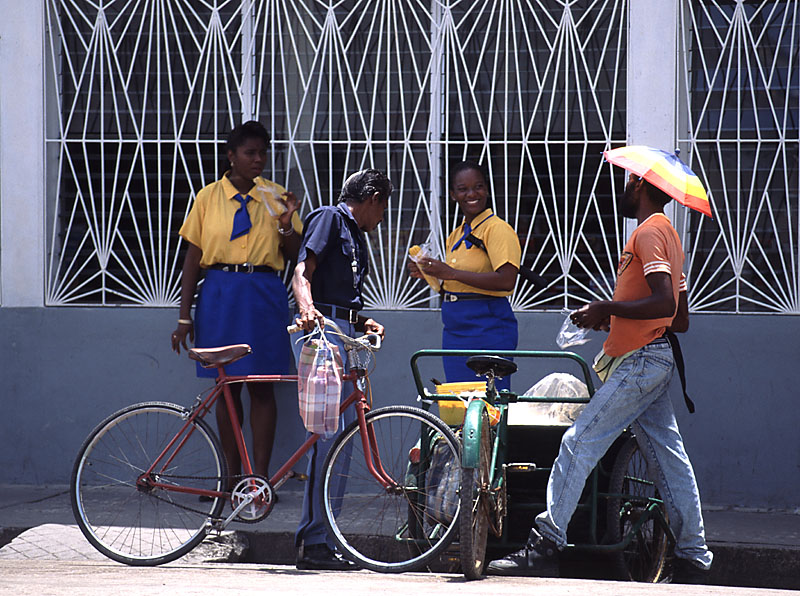
Overall, most Belizeans are very modest and private indeed. Many women still swim fully clothed. Public displays of affection of any kind are discouraged. There is no topless or nude sunbathing allowed (although you may see young European women sunbathing topless on rare occasions at certain resorts).
There is no such thing as a gay bar, there is no need for one. There is no ‘pride’ here because people have more important things to think about than gay pride. Private parties are the venue of choice for most gay couples on the mainland because any public display of affection is frowned upon, whether by gay or straight people. Gay people do not need to ghetto-ize themselves here. This is such a small and tight community that everyone knows everyone anyway. There are occasional private parties here as well, attended by gay and lesbian people, but they aren’t parties where people go to make out or cruise; they are just friendly get togethers.
While it is a rather sexualized community in some ways, talking about sex is still relatively taboo and this is represented in the sad statistic that Belize has the highest incident of HIV infection in Central America. Abstinence is still the only form of safe sex recommended in most schools and by community leaders. The use of condoms is rejected by the Church and also by men as part of the macho culture. As well, because tourism is the major source of income for the country, sex becomes part of that and is a big issue in terms of transmissible disease.
Belize City can be a very violent area and suffers a scourge of gang culture, guns and drug crime. It is not a great place for any visitor to spend much time and is not recommended. Straight, gay, male or female, it is probably best to avoid the city whenever possible. It’s a rough area and no one in their right mind would want to be there late at night or even spend much time there at all, but the rest of Belize is wonderful.
As in many conservative places in the world, same-sex female relationships are more accepted than are male relationships. That said, we see male gay tourists wandering around all the time enjoying the country and not experiencing any problems at all. As mentioned earlier, it is a lot more acceptable to be a gay outsider. I certainly wouldn’t want to come out in my high school here and I doubt many can or do.
 Many gay male Belizeans marry and have children and then go on to have same sex relationships later in life. The ‘sweetheart’ culture also exists here, with one man married to one woman officially but acting as spouse and parent to more than one family. This also occurs amongst gay men who are married with children.
Many gay male Belizeans marry and have children and then go on to have same sex relationships later in life. The ‘sweetheart’ culture also exists here, with one man married to one woman officially but acting as spouse and parent to more than one family. This also occurs amongst gay men who are married with children.
Belize will welcome you as a gay or lesbian tourist, but don’t expect to find a ‘scene’. Expect to be welcomed, treated with respect and kindness by everyone you meet. There are many places on the Internet to find gay-friendly accommodation but feel free to book into any resort in the country and feel welcome.
Do not come here if you want to nude sunbathe, cruise or show public displays of affection as that is neither welcomed or tolerated.
Come here if you want an amazing and life changing adventure by playing in waterfalls, visiting Maya ruins, exploring caves, zip lining through the forest canopy, seeing endangered wildlife in their natural environment, hearing howler monkeys in the jungle, seeing flocks of parrots flying freely.
Or come here if you want to dive the largest barrier reef in the Northern hemisphere, experience the amazing Blue Hole, swim with dolphins, rays, sharks and manatees in the open sea, walk for miles on sandy tropical beaches, reef and deep sea fish, kite surf or just sit in beach bars and enjoy local music.
We keep a blog of life here which includes a write-up about a big ‘gay event’ that happened in San Pedro this past year. Here is the excerpt about that event:
“We and some locals were having a birthday party one evening when a golf cart full of stunning women went by. By stunning, I mean they were dressed up like glamour goddesses, made up like drag queens (maybe that should have been a giveaway) and they received plenty of hoots and hollers as they putted by.
“Given that this was the most rocking place in San Pedro that night, they turned around, came into our party, danced, posed for pictures and disappeared into the night. When they left, many men had smiles on their faces as women here don’t often dress up in sequins, high heels and mini skirts. We found it amusing that most of these guys didn’t notice (or did they choose not to notice?) that this was a group of women who averaged about 6’6” in height.
“Still not getting it?
Ok, we’ll have to crack and get to the point: 150 gay, lesbian and transgendered divers spent a week in San Pedro. They were from all over the world. Aussies, Brits, USAers, Dutch folks etc. They belong to a group called Diving for Life that does a big dive trip annually to raise money for HIV and AIDS charities. So far they’ve raised over half a million dollars just by organising dive trips and having a bloody good time.
“They made a substantial donation to our local AIDS charity, spent a lot of money on the island, tipped (from what we hear) extremely generously and generally brightened up low season on San Pedro to no end. On their last night, they held a costume party and of course, we were invited. Now, some of these guys and gals brought a whole suitcase just to hold their costume. So, we were certainly not disappointed. We have to admit, our birthday bash was great, but this party was fantabulistic.” (photo above)
You see, life in Belize is not what you think, eh?
Have a further read on our blog and then come and visit. (http://exploringbelizecontinues.blogspot.com/2007_10_01_archive.html)
And by the way you might find it interesting to check out the following for further information. These are resorts that choose to advertise as gay friendly. I can’t think of a single resort that would have any issues with a gay or lesbian couple. Actually I lied: there is one, owned by a North American Evangelical preacher.
http://gayjourney.com/hotels/belize.htm
http://www.gayvacationplacestostay.com/hotels-resorts/details.cfm?id=767
http://www.pinkchoice.com/propertyDetail_v2.aspx?id=885&content=Macaw+Bank+Jungle+Lodge+San+Ignacio,+Cayo+Belize+Belize+hotels
Follow-up Questions
In response to this engaging commentary, GlobalGayz asked some follow-up questions:
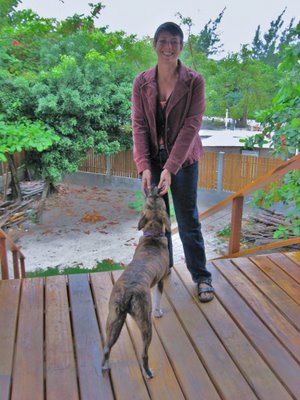 GlobalGayz:
GlobalGayz:
You are both from London. What’s the ratio of expats to natives in San Pedro (photo right) ?
Colette: (photo left)
We both lived in London for 25 years previous to moving to Belize. We are both fairly international and have lived in Europe and the United States at different times. Neither of us have ever lived in Canada although we both think the people are lovely and it seems very beautiful. I think there are an estimated 2,000 expats in San Pedro of approximately 20,000 residents.
GG:
Regarding the T in LGBT, is there any trans life in Belize? Is there any tradition that allows for ‘lady boys’ or cross-dressers or transsexuals to have a place in the indigenous cultures?
C:
There have been transgendered folks in Belize and we’ve seen a few living in San Pedro on and off. They keep themselves very much to themselves. I think it might be tough for them here due to the machismo of the culture. I am not aware of any historical cultural tolerance of gender cross over here. But people are very non judgmental in San Pedro.
GG: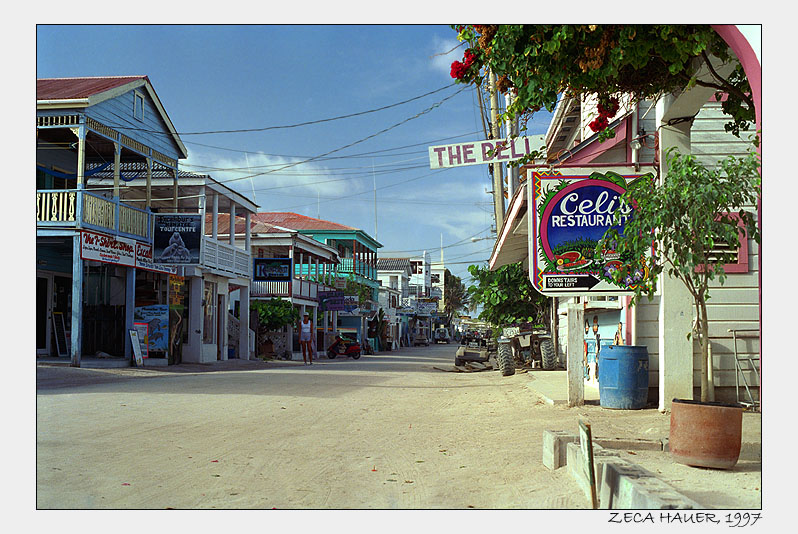
Regarding the G in LGBT, is there about an equal number of gay guys and lesbian women in the community there? Is there a mix? Do the men and women interact with ease or is there separation between the genders socially?
C:
I don’t know the true demographics of the gay/lesbian population locally although I could say I know just as many gay men as I know women. They do mix socially both with each other and with straight people. (photo above: San Pedro)
GG:
If a native son or daughter was found to be gay what might be the worst response from their family? The best of course would be acceptance. What is the level of homophobia there? Would a family member be at risk of harm? Have you heard for any gay person being harmed or threatened?
C:
There is every extreme I am sure when families have gay children. In rural areas, I have heard terrible stories about young people being beaten for being suspected to be gay or lesbian. But kids are still beaten in schools here and they are beaten for all sorts of things by their parents. I’ve not been around someone through the process of coming out to their family, so I can’t really give you any personal observations. But I would say in rural areas on the mainland the fear of homophobia would be greatest, but you have to remember that this is a country where schools and even police training centres have been shut down for ‘demon possession’ within the last year.
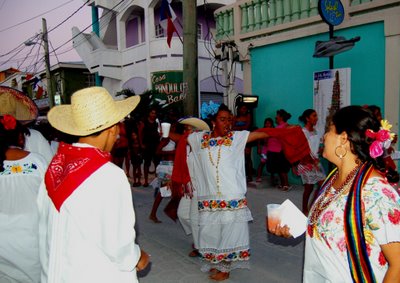
There have been unexplained murders that may have been homophobic, but almost all serious crime happens in Belize City, which statistically is one of the most violent places anywhere. People get shot and killed there on a daily basis, so if someone is killed who happens to be gay, it could be homophobic but probably is more likely to be drug or gang related. Fortunately murder in San Pedro is very very rare and in most cases it is drug related or a crime of passion. (photo left: natives dancing)
GG:
I read “male same-sex sexual activity is illegal in Belize, with a penalty of 10 years imprisonment but female same-sex sexual activity is legal”. Is this true and do women have an easier time of it? Are there any proposed changes tothe law?
C:
Laws about sex are strange everywhere. I’ve never heard of anyone here being arrested here for sodomy. In fact, most sex crimes here go unreported and if reported, un prosecuted. As far as I am aware oral sex between consenting adults of any gender is still illegal in Georgia, Florida, Louisiana and several other U.S. states. Go figure.
GG:
Do you have a statistic about the prevalence of HIV/AIDS since sex is not talked about and condoms are frowned upon? While we all think of love as a great thing we need to remember that love, or the pursuit of love, can lead to serious consequences, particularly for the young.
C: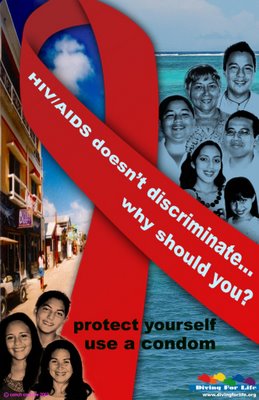
Maya and I are involved with the San Pedro Aids Commission in San Pedro.
It is part of the Belize National Aids Commission. The San Pedro Aids Commission has many accomplishments under its belt already including:
- Teacher training
- Educational materials for young people
- Production of AIDS informercial
- Production of AIDS awareness posters and billboards
- Financial assistance for people living with AIDS and their families
Our commission even managed to win 1st place at the San Pedro Lighted Boat Parade last year with their fantastic floating red ribbon. To put it all in context here are some of the most up to date figures on HIV/AIDS in Belize:
- Total population of Belize: 294,385 (2007 est.)
- Estimated number of people living with HIV/AIDS by the end of 2007: 3,400
- Estimated percentage of adults (ages 15-49) living with HIV/AIDS by the end of 2007: 2.1%
- Estimated percentage of HIV cases that occured among women (ages 15-49) by the end of 2007: 59%
- Estimated number of children (ages 0-15) living with HIV/AIDS by the end of 2007: less than 200
- Estimated number of deaths due to AIDS during 2007: less than 200
Source: UNAIDS 2008 Report on the Global AIDS Epidemic. July 2008.
The San Pedro Aids Commission is sustained wholly by volunteers and community contribution and does a wonderful job. They are about to introduce condom machines to San Pedro to be placed in ‘useful’ locations.
GG:
Can you please say more about the ‘sweetheart’ culture, including the
aspect of a man “acting as spouse and parent to more than one family”. How does that work? Is it openly known to the ‘wives’?
C:
The sweetheart culture is exactly what I said it is. Yep, the legal wife almost always knows of the other girlfriends and wives. She may not like it, but that is the way it is. There is a huge element of ‘down low’ behaviour here and many men here have several children, often by several women as well as participating regularly in same-sex behaviour. This is one of the reasons we have the highest incidence of HIV in Central America.
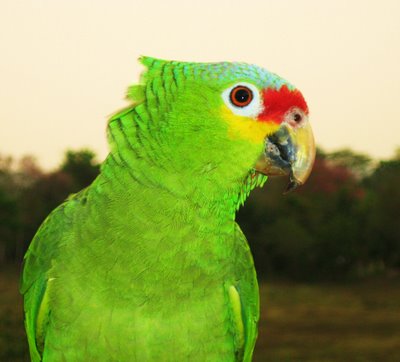
In your blog, you mention high season and low season. Please say when is which and why do tourists not come in low season–too hot? Which months are high season? When are hurricanes likely to attack?
C:
High season tends to be between December and May and is centered around USA holidays as the tourists come here to visit during those times. June through November is hurricane season and also low season here. During the months of August and September, many businesses close completely.
GG:
How much money would a person need to live modestly for a year your area?
How do you and Maya support yourselves without your Brit careers?
C:
Modestly is a subjective word. You can live quite cheaply if you don’t have air conditioning and rent away from the beach, only eating local food and no motorised transportation. Otherwise, most people recommend a minimum of $2,000usd per person per month in San Pedro. On the mainland you can do it for half of that. We do photography primarily although we don’t display our work on the blog. I do some PR and voice over work as well as writing and Maya does video work.
Finally
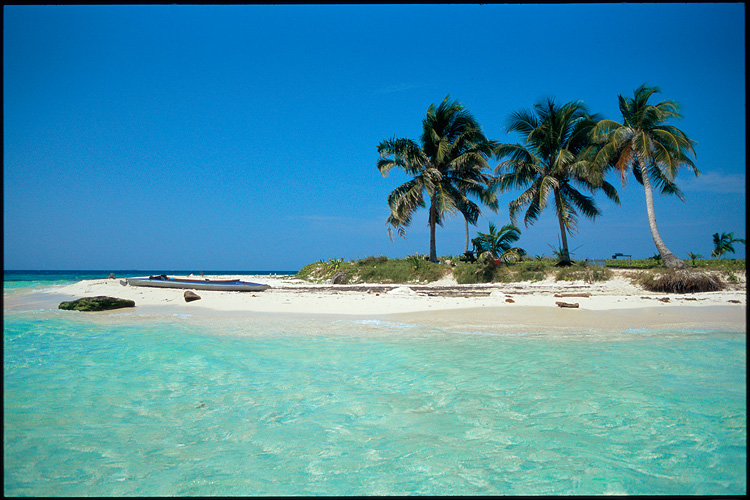 So, two of life’s most precious commodities, sex and money, seem not to be a problem in this corner of the planet. Although there is a financial disparity between the ‘immigrant’ expats and the native locals it does not appear to bother anyone, especially since the expats spend their money locally for housing, food, merchandise and services. Everyone wins which is a good way to co-habitate. Whether one is gay or not money still has the same color and value in San Pedro; and varieties in the ways people love appear to have the same result–kindness and respect. For many LGBT people and for many Belizeans this is the good life.
So, two of life’s most precious commodities, sex and money, seem not to be a problem in this corner of the planet. Although there is a financial disparity between the ‘immigrant’ expats and the native locals it does not appear to bother anyone, especially since the expats spend their money locally for housing, food, merchandise and services. Everyone wins which is a good way to co-habitate. Whether one is gay or not money still has the same color and value in San Pedro; and varieties in the ways people love appear to have the same result–kindness and respect. For many LGBT people and for many Belizeans this is the good life.
Other links to Belize:
Belize Tourism Board
http://www.travelbelize.org/
Government of Belize site
http://www.governmentofbelize.gov.bz/

